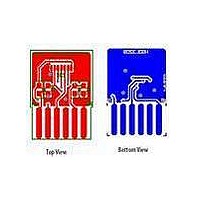HSDL-3209-021 Lite-On Electronics, HSDL-3209-021 Datasheet - Page 9

HSDL-3209-021
Manufacturer Part Number
HSDL-3209-021
Description
Infrared Transceivers IR Transceiver 115Kb/s
Manufacturer
Lite-On Electronics
Datasheet
1.HSDL-3209-021.pdf
(16 pages)
Specifications of HSDL-3209-021
Wavelength
875 nm, 880 nm
Continual Data Transmission
115.2 Kbit/s
Radiant Intensity
14 mW/sr
Half Intensity Angle Degrees
30 deg to 60 deg
Pulse Width
4 ms, 1.6 ms
Maximum Rise Time
60 ns, 600 ns
Maximum Fall Time
60 ns, 600 ns
Led Supply Voltage
0 V to 6.5 V
Maximum Forward Current
50 mA
Operating Voltage
2.4 V to 3.6 V
Maximum Operating Temperature
+ 70 C
Minimum Operating Temperature
- 25 C
Dimensions
7 mm x 2.8 mm x 1.6 mm
Data Rate
115.2kbs (SIR)
Idle Current, Typ @ 25° C
100µA
Link Range, Low Power
30cm
Operating Temperature
-25°C ~ 70°C
Orientation
Side View
Shutdown
*
Size
7mm x 2.8mm x 1.6mm
Standards
IrPHY 1.4
Supply Voltage
2.4 V ~ 3.6 V
Lead Free Status / RoHS Status
Lead free / RoHS Compliant
Available stocks
Company
Part Number
Manufacturer
Quantity
Price
Company:
Part Number:
HSDL-3209-021
Manufacturer:
AVAGO
Quantity:
2 385
The reflow profile is a straight-line representation of a
nominal temperature profile for a convective reflow sol-
der process. The temperature profile is divided into four
process zones, each with different DT/Dtime temperature
change rates. The DT/Dtime rates are detailed in the above
table. The temperatures are measured at the component
to printed circuit board connections.
In process zone P1, the PC board and HSDL-3209 castella-
tion pins are heated to a temperature of 160°C to activate
the flux in the solder paste. The temperature ramp up rate,
R1, is limited to 4°C per second to allow for even heating
of both the PC board and HSDL-3209 castellations.
Process zone P2 should be of sufficient time duration (60
to 120 seconds) to dry the solder paste. The temperature is
raised to a level just below the liquidus point of the solder,
usually 200°C (392°F).
Process zone P3 is the solder reflow zone. In zone P3,
the temperature is quickly raised above the liquidus
Recommended Reflow Profile
Process Zone
Heat Up
Solder Paste Dry
Solder Reflow
Cool Down
160
120
230
220
180
255
200
25
80
0
R1
HEAT
UP
P1
Symbol
P1, R1
P2, R2
P3, R3
P3, R4
P4, R5
50
R2
SOLDER PASTE DRY
DT
25°C to 160°C
160°C to 200°C
200°C to 255°C (260°C at 10 seconds max)
255°C to 200°C
200°C to 25°C
P2
100
point of solder to 255°C (491°F) for optimum results. The
dwell time above the liquidus point of solder should
be between 20 and 60 seconds. It usually takes about
20 seconds to assure proper coalescing of the solder
balls into liquid solder and the formation of good solder
connections. Beyond a dwell time of 60 seconds, the
intermetallic growth within the solder connections be-
comes excessive, resulting in the formation of weak and
unreliable connections. The temperature is then rapidly
reduced to a point below the solidus temperature of the
solder, usually 200°C (392°F), to allow the solder within
the connections to freeze solid.
Process zone P4 is the cool down after solder freeze.
The cool down rate, R5, from the liquidus point of the
solder to 25°C (77°F) should not exceed 6°C per second
maximum. This limitation is necessary to allow the PC
board and HSDL-3209 castellations to change dimen-
sions evenly, putting minimal stresses on the HSDL-3209
transceiver.
150
R3
MAX 260C
Above 220 C
REFLOW
SOLDER
60 sec
MAX
P3
200
R4
COOL DOWN
P4
Maximum
R5
250
0.5°C/s
-6°C/s
-6°C/s
4°C/s
4°C/s
(SECONDS)
T/
D
t-TIME
time
D
300





















